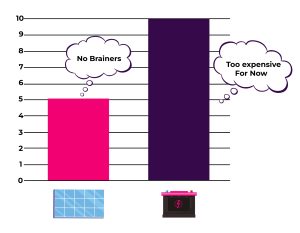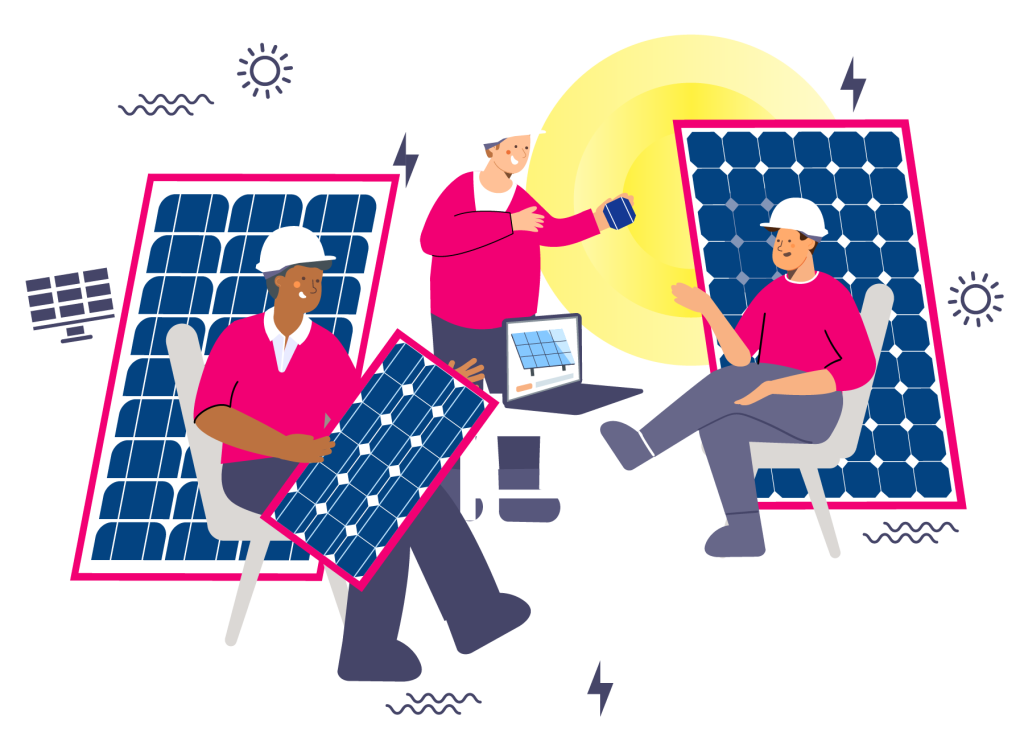
Before You Buy Solar:
Avoid these 7 mistakes and find the best solar installer for you
- Avoid getting ripped off
- Know what questions to ask
- Find the right installer
Determining the reliability of a solar energy provider can be a tricky task.

Get tiny bills for decades and save the planet by avoiding these 7 mistakes
Mistake #1
Waiting for batteries prices to drop
 Investing in a battery is often met with apprehension, particularly due to its price. At the current moment, installing a Tesla Powerwall system would cost approximately $19,000 and take up to 19 years to pay back.
Investing in a battery is often met with apprehension, particularly due to its price. At the current moment, installing a Tesla Powerwall system would cost approximately $19,000 and take up to 19 years to pay back.
The system has a ten year warranty. It is easy to understand why people may hesitate to commit to a purchase such as this; however, waiting for the cost of batteries to become more affordable should not be the reason one avoids investing in solar. Despite battery costs expected to drop year-by-year, the most efficient course of action is to take advantage of solar power without battery storage.
Every day you don’t have solar is another day you do have to pay high electricity bills. A well designed solar system without batteries can give you tiny bills.
With solar energy becoming increasingly cost–effective, it would be a shame to wait 2, 3 or 4 more years to benefit from affordable batteries and consequently, miss out on potential savings during that time. But you can still go solar now and simply retrofit batteries at a later stage when the cost makes sense. With AC coupling, adding them to your existing system will be an easy task. So don’t wait around for cheaper batteries to arrive; make the most of the present situation and consider investing in solar now.
Mistake #2
Not getting multiple quotes
Gathering multiple quotes for any purchase, particularly for solar energy, is essential for getting an accurate read on how much it will cost and to make sure you aren’t overpaying. With this information, you can be sure that solar is a wise financial decision and that you’re getting a quality product.

$20,000
FOR A $5,000 SYSTEM
Mistake #3
Those unfamiliar with the distinction between solar rebates and solar feed-in tariffs should take the time to become better informed.
The ‘solar rebate’ works like a price reduction when you purchase a solar system, and it is requested by your solar installer on your behalf. The ‘feed in tariff’ is the money that your electricity retailer pays you for every kilowatt–hour of excess solar power that you send into the grid. Prices of the feed in tariff range from 0-12c/kWh, so make sure to do your research to get the best deal. Quotes you may come across usually have the ‘solar rebate’ applied already.
This discount usually amounts to about $450 per kilowatt of installed solar panels, although the exact amount can vary depending on your location. As an example, a 6.6 kW system will earn you around $3,000 in rebates. All in all, this rebate is open to anyone – regardless of whether you have bought solar power systems in the past or not.
Mistake #4
Not knowing what protections you’re entitled to under Australian consumer law
 Almost every week someone will tell me that they’ve had a solar installer tell them that they need to have their systems serviced once every two years (or more) in order for the system to stay in warranty.
Almost every week someone will tell me that they’ve had a solar installer tell them that they need to have their systems serviced once every two years (or more) in order for the system to stay in warranty.
This is bollocks. Speaking as a chartered electrical engineer, good-quality solar systems will only need to be serviced once every 5 years, and cleaned once per year.
If you have a slimy salesman telling you that you’ll need to pay some kind of ‘maintenance fee’ to keep your panels in warranty, show them the door.
Another tactic that dishonest salesmen use is to assure you that your solar systems will have a 25 year ‘performance warranty’, to make it seem like any problems that befall your system will be covered under this apparent 25-year warranty.
Unfortunately, this isn’t the case. It’s very easy for solar manufacturers to wriggle out of this ‘performance warranty’, by claiming that any defects in the panels fall under the ‘panel warranty’, which can only be 5 years in some cases.
In reality, there are actually four separate warranties that you get with your solar system – the ‘performance warranty’ being one of them. The other three are for your inverter, the panels themselves, and the workmanship. In terms of warranty, what you really want to look for is:

10 YEAR WARRANTY for your inverter

12 YEAR WARRANTY for your solar panels

5 YEAR WARRANTY for the workmanship
Mistake #5
Not asking the hard-hitting questions to separate the solar installer wheat from the chaff
The only thing shonky installers hate more than an ACCC investigation is a customer who knows their stuff! With knowledge comes power, and if a shonky installer realises that you know solar, their ability to rip you off just took a nose dive and they know it.
Always, always, always independently verify information, whenever possible. There are numerous resources available to help you verify what solar salesmen tell you (the Whirlpool forums are one of my favourite sources of such information), but if Google can’t help you, I will. Just shoot me an email here.

Solar battery installation
- Premium Solar Battery Options
- Hassle Free Battery Installation
- High Performance Warranty
- Local Customer Support Service
- Value for Money products
You Can Save Up To $2950.
By submitting this form, you consent to be contacted by Solar Emporium and receive communications from time to time. Please view our privacy policy for further information.
Mistake #6
How many panels should you buy?
My answer to this question has changed considerably compared to just a few years ago.
This is because prices for solar installation have fallen considerably and electricity prices have risen.
The only limitations now are your budget, what your roof can properly fit, and the amount your DNSP (Distributed Network Service Provider) allows you to install.
For most homes, this means the sweet spot is 6.6kW of panels (approx. 18 in total) with a 5kW inverter.
The biggest regret I’ve heard from solar power owners is they didn’t factor in how winter limits electricity bill savings from their system. They wish they installed more panels when they had the chance, as it’s expensive and complicated to add panels later to an existing system.
I’ve written about this topic in more detail here.
Mistake #7
Thinking that because your roof isn’t north-facing, solar isn’t worth it
This couldn’t be further from the truth! Solar panel efficiencies have reached the point where, even if your panels aren’t facing north, you only lose 10-15% of your solar system production – which means that the system is still well worth the investment.
In fact, depending on the time of day you use your electricity, it may make more sense for your solar panels to face east or west (for morning or evening heavy electricity usage habits, respectively). I go into greater detail about this topic here.
Every review tells a story, the story of a customers experience.
Rita L Camilleri
Satisfied
Michelle was so helpful with explaining how solar works and did all the workings out re rebates etc for me. Any queries I had, Michelle was always approachable to help me out. The trades people that came to install my solar were professional and friendly.
Abdullah Al Amin
Great company to deal with
Great company to deal with. A+ customer service. The consultant Mr Nashiq Ahmed is simply the best. He answered all my questions and provided me best possible options. The installer electrician was quite knowledgeable and did a great job. Highly recommended.
Leon
Succeeded as advertised
Sale info was honest, direct, and complete. Multiple options were provided, and no issues occurred in installation. Not a single thing broken in the roof. Finally got the bill, and the results are as promised. We're very satisfied with the whole experience.
Philmac
We found Michelle from Solar emporium…
We found Michelle from Solar emporium fantastic to deal with, she explained every part of the installation process and long term benefits of the system. She was very honest with her recommendations and gave great examples. The installers were very professional, thorough and on time everyday with good communication. The whole process from start to finish was excellent.
khan Ruon
The process went very smoothly from the beginning to end...
I had my solar installed by solar Emporium recently and the process went very smoothly from the beginning speaking with William in sales who was very thorough to installation which was professional and fast. Definitely look at these guys if you are looking to get solar. Thank you so much guys for job you
Ron Steele
Excellent service from solar emporium…
Excellent service from solar emporium their installers were very good and polite did a great job thanks boys.
